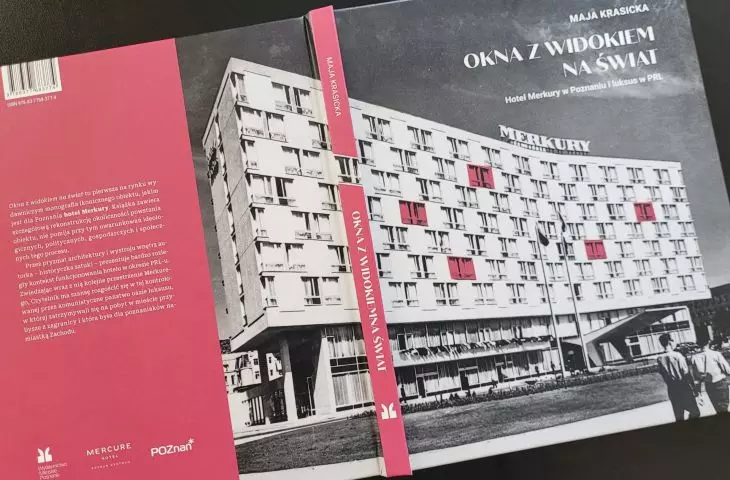Poznan's 1964Mercury Hotel (today: Mercure) has not yet been described and appreciated as it deserves. This has changed thanks to a just-published monograph of the building by Maja Krasicka. It was the first such modern hotel in Poland; a pioneer in many respects. It has served the same function for exactly 60 years, although it had to undergo changes that raised its standard, but hurt the architecture a bit.
Communist luxury and the associated standard of living that exceeded the low standards of the time has been in vogue lately. The topic is returning in research, exhibitions and publications. And since the manifestation of luxury in People's Poland was largely representative hotels run by Orbis, we are learning more and more about both their form and their importance to the society of the time, which exceeded pure utility. There was much on this subject in the book "The Moon from Pewex. On Luxury in the People's Republic of Poland" by Aleksandra Boćkowska seven years ago. The exhibition "Rationed Modernity. Modernism in the People's Republic of Poland." One of its main curators, Professor Andrzej Szczerski, pointed out in his essay that they were supposed to create an image of prosperity, and the
this image was to neutralize the actual political and economic problems.
It is worth adding, however, that the high quality of architecture and the functioning of luxury hotels also raised frustrating, because unfulfillable, aspirations. It also showed that Polish architects (this applies mainly to the 1960s) - with adequate funds, technical and material base - were easily able to create works of world standard. One such luxurious specimen was Poznan's Hotel Mercury, the flagship investment of the fair city completed in 1964, built in a prominent location next to the MTP grounds, at today's Kaponiera traffic circle. A pioneering building in many respects, although not as well known and remembered as the slightly younger Cracovia in Cracow, or the later (no longer thoroughly Polish) Forum and Victoria in the capital.
The book "Windows with a view of the world. Hotel Merkury in Poznań and luxury in the People's Republic of Poland" by Maja Krasicka, Posnania City Publishing House
photo: Jakub Głaz
Little-known luxury of PRL
Three years ago in the FORMY portal Michal Blaszczynski, an art historian, academic lecturer and curator of the furniture department of the National Museum in Poznan, wrote:
Despite the significant importance of this object for the history of architecture and furniture in Poland, it has not received the attention of researchers, resulting in a small number of publications about it.
At the same time, Blaszczynski describes Mercury in some detail, although he stipulates that his article only "wants to become a contribution to further research."
The book "Windows overlooking the world. Hotel Mercury in Poznań and luxury in the People's Republic of Poland" by Maja Krasicka, Posnania City Publishing House
photo: Jakub Głaz
Further research followed, and the result is the book "Windows with a View of the World. Hotel Merkury in Poznań and luxury in the People's Republic of Poland." This is the debut of Maja Krasicka, a recent graduate of the Institute of Art History at Adam Mickiewicz University in Poznan, and the monograph on the Mercury is the aftermath of her highly acclaimed master 's thesis. Thus, the hotel has finally lived to see a study devoted exclusively to it, although it should be noted right away that it is not a complete monograph. It breaks off a quarter of a century ago, when the property fell into the hands of an international company, was thoroughly modernized and began operating under the Mercure banner. At that time, the period decor was almost completely obliterated. Fortunately, the shape of the very well-conceived, lightweight three-winged block survived. But - under the dictates of the new layout of the rooms - the facades were then simplified. Their characteristic checkerboard layout disappeared, replaced by banal divisions. Another thing is that the current appearance of the facades resembles the original design later improved during the rather lengthy preparations for construction.
Hotel Merkury now (as Mercure hotel) - view across Kaponiera traffic circle from under the Bałtyk office building
photo: Jakub Glaz
total design: from solid to detail
What was the aforementioned pioneering of the Mercury? It was the first project in postwar Poland for a thoroughly modernist luxury hotel of "Western" standards. The design of the Mercury was created at the end of 1956, that is, before the country's better-known modernist hotels: Cracovia (competition of the late 1950s, designed by Witold Ceckiewicz) and Warsaw's Dom Chlopa, not owned by Orbis, however (competition of 1957, designed by Bohdan Pniewski, Maria Malgorzata Handzelewicz-Waclawek). Three Poznań-based teams were invited to compete for the design of a luxury hotel intended mainly for guests of the Poznań International Fair: Stanisław Pogórski and Henryk Jarosz, Stefan Słoński and Bogdan Cybulski, and Jan Cieśliński and Jan Węcławski (cooperation: Izabella Wisłocka). The victory went to the last team.
The book "Windows overlooking the world. Hotel Merkury in Poznań and luxury in the People's Republic of Poland" by Maja Krasicka, Posnania City Publishing House
photo: Jakub Głaz
The construction of the Mercury was also a reason to create a series of modern hotel furnishings and furniture - so far unproduced in the country. Their design was handled by Węcławski, who was involved in design at the then State Higher School of Fine Arts (today: the University of Arts). Cieslinski, in turn, focused on thoughtful interior design. Because the Mercury, like buildings that both architects may have been inspired by (e.g., the UNESCO headquarters in Paris), was a total work - conceived coherently from general to detail.
The book "Windows overlooking the world. Hotel Merkury in Poznań and luxury in communist Poland" by Maja Krasicka, Posnania City Publishing House
photo: Jakub Głaz
At the same time, the author emphasizes the ease with which all the designers participating in the competition jumped from top-down imposed socialist realism to modernist forms with a level equal to Western realizations. This proves that - despite restrictions on the flow of information - they not only oriented themselves in world trends, but were able to creatively transform them. The elder Jan Cieslinski, moreover, was already designing in the modernist spirit before the war. Both he and Węcławski, by the way, deserve separate monographs. The diary kept by Cieslinski and the design documentation - Wêclawski's inheritance - made available to the author can be a contribution to it. Interesting and numerous illustrations (especially those showing alternative versions of the hotel and furniture designs) are, moreover, a great value of the solidly prepared publication.
The book "Windows with a view on the world. Hotel Merkury in Poznań and luxury in the People's Republic of Poland" by Maja Krasicka, Posnania City Publishing House
photo: Jakub Głaz
history of life, not just architecture
Sketches and furniture designs by the latter are a valuable element of the monograph of the Mercury, a book that successfully balances between an academic case study and a popular work, dealing not only with architecture, its well-documented genesis, but also with the later functioning of the hotel and its significance for residents and visitors. It is therefore not a purely architectural monograph. After skillfully guiding the reader through the interiors of the hotel and presenting its furnishings, the author introduces us to the life filling the building: from the iconic café in Poznan, through the restaurant, hotel club, drink bar, Pekao kiosk and later Pewex store , to the rooms and suites. There is also - which is probably already an indispensable ornament of stories about communist-era hotels - the memory of the room of undercover agents spying on guests. All with the memories of former employees and regulars woven in, in the spirit of "oral history."
The book "Windows overlooking the world. Hotel Merkury in Poznań and luxury in the People's Republic of Poland" by Maja Krasicka, Wydawnictwo Miejskie Posnania
photo: Jakub Glaz
During the author's meeting and promotion of the book, Prof. Piotr Korduba, director of the Institute of Art History at the Adam Mickiewicz University, stressed the importance of the university's cooperation with the owner of the hotel, which sponsors the book published by Wydawnictwo Miejskie Posnania. He expressed hope that such practice will become more frequent. On the one hand - right, but on the other hand - it's hard not to get the impression that the result of this cooperation is the abandonment of the story of the last 25 years of the hotel, as well as the lack of analytical reference to the redevelopment, which continues to give the Mercury its present, inferior appearance. And it's not just a matter of criticizing the decisions made a quarter-century ago (the design of the remodeling: Wojciech Kolesinski Design Studio), but rather of explaining their reasons in more detail and giving a voice to the authors of the redesign. In doing so, a reflection that was voiced during the author's meeting should resound: if it were not for the functional changes, perhaps the Mercury would have disappeared from the city's landscape altogether, as happened to other Polish specimens of socmodernism.
The book "Windows with a View of the World. Hotel Mercury in Poznań and Luxury in the People's Republic of Poland" by Maja Krasicka, Posnania City Publishing House
photo: Jakub Głaz
Fortunately, nothing is lost. Krasicka announced during the promotion of the book that she will study the architecture and phenomenon of Orbis hotels more extensively as part of her doctorate . Thus, there will be an opportunity to bring the story of them to the present day and - which could be an interesting topic of research - to show in detail what changes they have undergone in recent decadesrecent decades, what caused these transformations and what this tells us about the attitude to architecture and design of postwar "luxury" modernism.













































